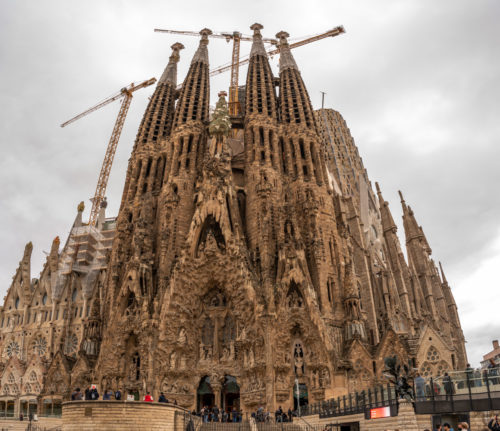
The third-day in Barcelona was covered in my last blog. During the afternoon we headed out to visit Gaudí’s greatest creation – Sagrada Família. Online Ticket was tough to get as it was being Sunday, there was quite a rush of tourists. So around 6 PM local time we could get into the church. We could not get the ticket to the towers which were separate and I sorely miss it. The vastness and the intricacy of this church are impossible to describe either by text or even by photos. But I have tried my best to represent what Gaudí was trying to show.
The Basílica i Temple Expiatori de la Sagrada Família is a large unfinished Roman Catholic church in Barcelona, designed by Catalan architect Antoni Gaudí (1852–1926). Gaudí’s work on the building is part of a UNESCO World Heritage Site, and in November 2010 Pope Benedict XVI consecrated and proclaimed it a minor basilica.
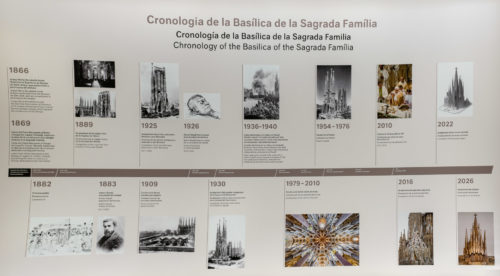
In 1882, construction of Sagrada Família started under architect Francisco de Paula del Villar. In 1883, when Villar resigned, Gaudí took over as chief architect, transforming the project with his architectural and engineering style, combining Gothic and curvilinear Art Nouveau forms. Gaudí devoted the remainder of his life to the project, and at the time of his death at age 73 in 1926, less than a quarter of the project was complete.

Sagrada Família has three grand façades: The Nativity façade to the East, the Passion façade to the West, and the Glory façade to the South (yet to be completed). The Nativity Façade was built before work was interrupted in 1935 and bears the most direct Gaudí influence.
Constructed between 1894 and 1930, the Nativity façade was the first façade to be completed. Dedicated to the birth of Jesus, it is decorated with scenes reminiscent of elements of life. Characteristic of Gaudí’s naturalistic style, the sculptures are ornately arranged and decorated with scenes and images from nature, each a symbol in its own manner.
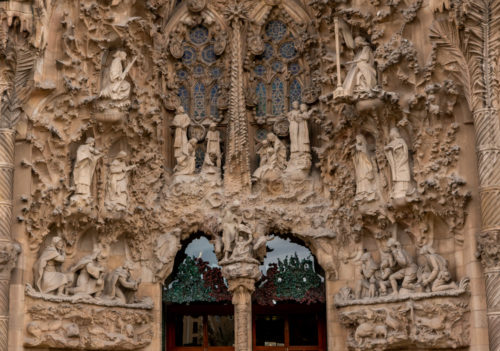
For instance, the three porticos are separated by two large columns, and at the base of each lies a turtle or a tortoise (one to represent the land and the other the sea; each are symbols of time as something set in stone and unchangeable). In contrast to the figures of turtles and their symbolism, two chameleons can be found at either side of the façade and are symbolic of change.

The façade faces the rising sun to the northeast, a symbol for the birth of Christ. It is divided into three porticos, each of which represents a theological virtue (Hope, Faith and Charity). The Tree of Life rises above the door of Jesus in the portico of Charity. Four towers complete the façade and are each dedicated to a Saint (Matthias the Apostle, Saint Barnabas, Jude the Apostle, and Simon the Zealot).

Originally, Gaudí intended for this façade to be polychromed, for each archivolt to be painted with a wide array of colours. He wanted every statue and figure to be painted. In this way, the figures of humans would appear as much alive as the figures of plants and animals.

The columns of the interior are a unique Gaudí design. He envisioned them to be like a forest with trees, branches. Besides branching to support their load, their ever-changing surfaces are the result of the intersection of various geometric forms. The simplest example is that of a square base evolving into an octagon as the column rises, then a sixteen-sided form, and eventually to a circle. This effect is the result of a three-dimensional intersection of helicoidal columns.

Gaudí thought forest was the greatest design created by god and that was how the interior of the church needs to be done. With all the different shapes, branches and the stained glass it definitely feels like one. Essentially none of the interior surfaces are flat; the ornamentation is comprehensive and rich, consisting in large part of abstract shapes which combine smooth curves and jagged points. Even detail-level work such as the iron railings for balconies and stairways are full of curvaceous elaboration.

Themes throughout the decoration include words from the liturgy. The towers are decorated with words such as “Hosanna”, “Excelsis”, and “Sanctus”; the great doors of the Passion façade reproduce words from the Bible in various languages including Catalan; and the Glory façade is to be decorated with the words from the Apostles’ Creed. The three entrances symbolize the three virtues: Faith, Hope and Love. Each of them is also dedicated to a part of Christ’s life. The Nativity Façade is dedicated to his birth; it also has a cypress tree which symbolizes the tree of life. The Glory façade is dedicated to his glory period. The Passion façade is symbolic of his suffering. The apse tower bears Latin text of Hail Mary. All in all, the Sagrada Família is symbolic of the lifetime of Christ.
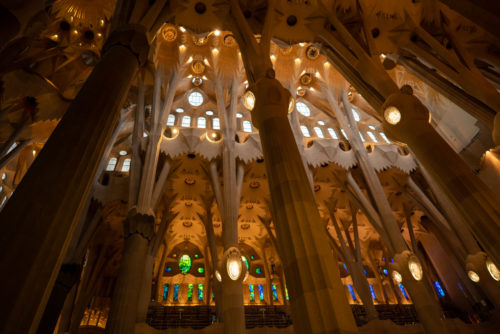
Relying solely on private donations, Sagrada Familia’s construction progressed slowly and was interrupted by the Spanish Civil War, only to resume intermittent progress in the 1950s. Since commencing construction in 1882, advancements in technologies such as computer-aided design and computerised numerical control (CNC) have enabled faster progress and construction passed the midpoint in 2010. However, some of the project’s greatest challenges remain, including the construction of ten more spires, each symbolising an important Biblical figure in the New Testament. It is anticipated that the building can be completed by 2026—the centenary of Gaudí’s death.
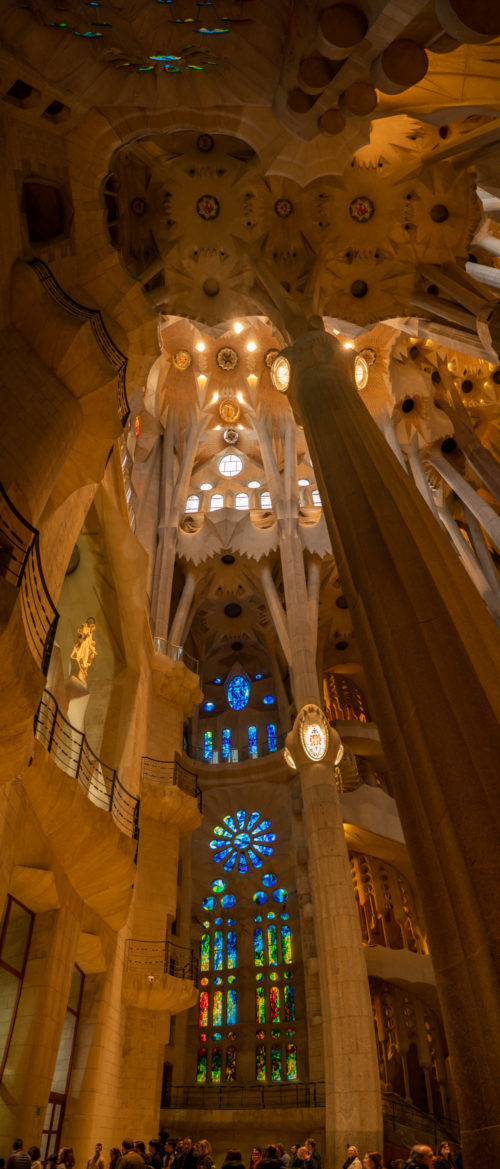


The style of la Sagrada Família is variously likened to Spanish Late Gothic, Catalan Modernism and to Art Nouveau or Catalan Noucentisme. While the Sagrada Família falls within the Art Nouveau period, Nikolaus Pevsner points out that, along with Charles Rennie Macintosh in Glasgow, Gaudí carried the Art Nouveau style far beyond its usual application as a surface decoration.


In common with Catalan and many other European Gothic cathedrals, the Sagrada Família is short in comparison to its width, and has a great complexity of parts, which include double aisles, an ambulatory with a chevet of seven apsidal chapels, a multitude of towers and three portals, each widely different in structure as well as ornament. Where it is common for cathedrals in Spain to be surrounded by numerous chapels and ecclesiastical buildings, the plan of this church has an unusual feature: a covered passage or cloister which forms a rectangle enclosing the church and passing through the narthex of each of its three portals.

Gaudí’s original design calls for a total of eighteen spires, representing in ascending order of height the Twelve Apostles, the Virgin Mary, the four Evangelists and, tallest of all, Jesus Christ. Eight spires have been built as of 2010, corresponding to four apostles at the Nativity façade and four apostles at the Passion façade.

The Evangelists’ spires will be surmounted by sculptures of their traditional symbols: a winged bull (Saint Luke), a winged man (Saint Matthew), an eagle (Saint John), and a winged lion (Saint Mark). The central spire of Jesus Christ is to be surmounted by a giant cross; its total height (170 metres) will be one metre less than that of Montjuïc hill in Barcelona as Gaudí believed that his creation should not surpass God’s. The lower spires are surmounted by communion hosts with sheaves of wheat and chalices with bunches of grapes, representing the Eucharist.

Gaudí chose this façade to embody the structure and decoration of the whole church. He was well aware that he would not finish the church and that he would need to set an artistic and architectural example for others to follow. He also chose for this façade to be the first on which to begin construction and for it to be, in his opinion, the most attractive and accessible to the public. He believed that if he had begun construction with the Passion Façade, one that would be hard and bare (as if made of bones), before the Nativity Façade, people would have withdrawn at the sight of it. Some of the statues were destroyed in 1936 during the Spanish Civil War, and subsequently were reconstructed by the Japanese artist Etsuro Sotoo.

In contrast to the highly decorated Nativity Façade, the Passion Façade is austere, plain and simple, with ample bare stone, and is carved with harsh straight lines to resemble the bones of a skeleton.

The Passion façade was built according to the design that Gaudi created in 1917. The construction began in 1954, and the towers, built over the elliptical plan, were finished in 1976. It is especially striking for its spare, gaunt, tormented characters, including emaciated figures of Christ being scourged at the pillar; and Christ on the Cross. These controversial designs are the work of Josep Maria Subirachs.
Dedicated to the Passion of Christ, the suffering of Jesus during his crucifixion, the façade was intended to portray the sins of man. Construction began in 1954, following the drawings and instructions left by Gaudí for future architects and sculptors. The towers were completed in 1976, and in 1987 a team of sculptors, headed by Josep Maria Subirachs, began work sculpting the various scenes and details of the façade. They aimed to give a rigid, angular form to provoke a dramatic effect. Gaudí intended for this façade to strike fear into the onlooker. He wanted to “break” arcs and “cut” columns, and to use the effect of chiaroscuro (dark angular shadows contrasted by harsh rigid light) to further show the severity and brutality of Christ’s sacrifice.

Facing the setting sun, indicative and symbolic of the death of Christ, the Passion Façade is supported by six large and inclined columns, designed to resemble Sequoia trunks. Above there is a pyramidal pediment, made up of eighteen bone-shaped columns, which culminate in a large cross with a crown of thorns. Each of the four towers is dedicated to an apostle (James, Thomas, Philip, and Bartholomew) and, like the Nativity Façade, there are three porticos, each representing the theological virtues, though in a much different light.


The scenes sculpted into the façade may be divided into three levels, which ascend in an S form and reproduce the Via Crucis of Christ. The lowest level depicts scenes from Jesus’ last night before the crucifixion, including The Last Supper, Kiss of Judas, Ecce Homo, and the Sanhedrin Trial of Jesus. The middle level portrays the Calvary, or Golgotha, of Christ, and includes The Three Marys, Saint Longinus, Saint Veronica, and a hollow-face illusion of Christ on the Veil of Veronica. In the third and final level the Death, Burial and the Resurrection of Christ can be seen. A bronze figure situated on a bridge creating a link between the towers of Saint Bartholomew and Saint Thomas represents the Ascension of Jesus.


On 10 June 1926 Gaudí died because of injuries sustained three days earlier when he was tragically knocked down by a tram. On 12 June he was buried in the Chapel of Our Lady of Mount Carmel in the crypt of the Sagrada Familia, where his mortal remains rest to this day. Here is the death mask of Gaudí made by Sculptor Joan Matamala.

The Glory façade, on which construction began in 2002, will be the largest and most monumental of the three and will represent one’s ascension to God. It will also depict various scenes such as Hell, Purgatory, and will include elements such as the Seven Deadly Sins and the Seven Heavenly Virtues.

The largest and most striking of the façades will be the Glory Façade, on which construction began in 2002. It will be the principal façade and will offer access to the central nave. Dedicated to the Celestial Glory of Jesus, it represents the road to God: Death, Final Judgment, and Glory, while Hell is left for those who deviate from God’s will. Aware that he would not live long enough to see this façade completed, Gaudí made a model which was demolished in 1936, whose original fragments were base for the development of the design for the façade. The completion of this façade will require the demolition of the complete block with buildings across the Carrer de Mallorca. To reach the Glory Portico the large staircase will lead over the underground passage built over Carrer de Mallorca with the decoration representing Hell and vice. It will be decorated with demons, idols, false gods, heresy and schisms, etc. Purgatory and death will also be depicted, the latter using tombs along the ground. The portico will have seven large columns dedicated to spiritual gifts. At the base of the columns there will be representations of the Seven Deadly Sins, and at the top, The Seven Heavenly Virtues.

The church plan is that of a Latin cross with five aisles. The central nave vaults reach forty-five metres while the side nave vaults reach thirty metres. The transept has three aisles. The columns are on a 7.5 metre grid. However, the columns of the apse, resting on del Villar’s foundation, do not adhere to the grid, requiring a section of columns of the ambulatory to transition to the grid thus creating a horseshoe pattern to the layout of those columns. The crossing rests on the four central columns of porphyry supporting a great hyperboloid surrounded by two rings of twelve hyperboloids. The central vault reaches sixty metres. The apse is capped by a hyperboloid vault reaching seventy-five metres. Gaudí intended that a visitor standing at the main entrance be able to see the vaults of the nave, crossing, and apse; thus, the graduated increase in vault loft.
Here is the computer animated version how it will look in 2026 after completion.
[youtube]RcDmloG3tXU[/youtube]
It was dark by the time we left the Sagrada Família. We had dinner at Cervecería Catalana. Best Tapas, pretty traditional, but still very trendy. Quite crowded, but worth every minute of waiting. Service is very fast. Food is excellent.

